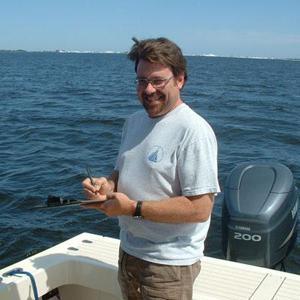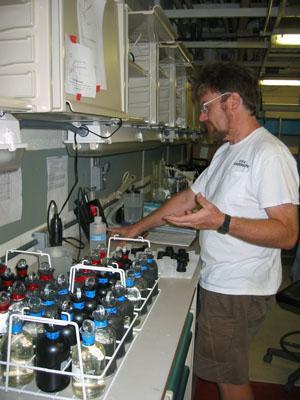Meet EPA Ecologist Michael Murrell, Ph.D.
EPA research ecologist Michael Murrell, Ph.D., is  EPA Ecologist Michael Murrell currently working on the Gulf of Mexico Hypoxia Project, helping develop models of the northern Gulf to quantify the links between freshwater flowing into the Gulf from the land, nutrients, and hypoxia—“dead zones”—on the continental shelf.
EPA Ecologist Michael Murrell currently working on the Gulf of Mexico Hypoxia Project, helping develop models of the northern Gulf to quantify the links between freshwater flowing into the Gulf from the land, nutrients, and hypoxia—“dead zones”—on the continental shelf.
How does your science matter?
My research improves our ability to predict how human activities affect the plants and animals living in coastal and estuarine waters. The health of these organisms tells us about the health of the water. For the past decade, our research group has focused on the effect of nutrient runoff from the Mississippi-Atchafalaya watershed and how it is linked to the formation of dead zones (i.e. hypoxic waters) in the Gulf of Mexico.
Excess nutrients come from things like agricultural runoff, fertilizer runoff from suburban lawns, erosion of soil full of nutrients, and discharges from sewage treatment plants. The delivery of nutrient-laden waters into the Gulf of Mexico stimulates algal blooms, and the river water promotes water stratification creating distinct surface and bottom water layers. In the bottom layer the sediment and plankton communities (mostly microbes) consume oxygen faster than it can be re-supplied from mixing. Thus bottom waters become progressively depleted of oxygen over the spring and summer seasons, making these zones uninhabitable for most marine animals to live (fish, crustaceans, and other invertebrates). That’s why they are often called dead zones, because not many things can live there.
A lot of our research is creating better models of how hypoxia works, specifically on the Louisiana shelf. The idea is that with robust models, we can use them to test our understanding—one scenario would be to imagine a world where humans had not changed the amount of nutrients coming into the Mississippi River. What would hypoxia look like then? Another is to use potential global climate change scenarios that affect freshwater flow and nutrient delivery patterns. We want to know how much we need to reduce nutrient levels to improve the situation in the Gulf of Mexico.
What do you like most about your research?
The thing that keeps me really interested is the puzzle: putting together the pieces. In a small way, when we go out and do sampling and experimental work, we are getting new pieces that help us form a more accurate picture of the world and the way it works.
If you could have dinner with any scientist, past or present, who would it be and what would you like to ask him or her?
I would have liked to have dinner with the American oceanographer and physiologist, Alfred Redfield (1890-1983), whose work has transformed our understanding of how life works on earth.
I like that his most profound contribution to science was based on a relatively simple observation. He observed that the elemental composition of planktonic organisms (their nitrogen and phosphorus content) almost perfectly matched the ionic composition of deep ocean water. These ratios, now commonly referred to as Redfield ratios, are key to our knowledge of the relationships between biology and chemistry on Earth in general and the oceans in particular. When and how these elements move through the biosphere has profound implications for current environmental issues, such as: global climate change, hypoxic zones, ocean acidification, and limits to agricultural and fisheries production.
I would ask him to tell me stories from his life and to describe how he approached the various puzzles that he was able to put together in the course of his scientific career.
When did you first know you wanted to be a scientist?  Dr. Murrell at work
Dr. Murrell at work
Math and science classes were always the most interesting to me in grade school and high school. As an undergraduate, I took a summer field course in marine ecology in south Louisiana, which I really loved. It was inspirational. When I look back, it seems like that was my “eureka” moment, but my interests developed gradually over the next several years both as a graduate student and as a marine technician. I just gravitated toward the idea that this was what I wanted to do.
Tell us about your background.
I earned a bachelor’s degree in Zoology at the University of Louisiana at Lafayette and a master’s degree in Zoology at Louisiana State University. I spent several years working as a research technician at different marine institutions across the country before enrolling at the University of California at Santa Cruz for my doctorate in Biology. My dissertation looked at microbial plankton processes and food web dynamics in the San Francisco Bay.
If you weren’t a scientist, what would you be doing?
I would like to teach. That’s something I haven’t done a lot of, but I enjoyed as a graduate student. Other than that, I like working with my hands. In my formative years, I was a bicycle mechanic. I really like understanding how things work—taking them apart, putting them back together.
Any advice for students considering a career in science?
If you want to pursue science, you have to do something for which you feel passion, because it’s sometimes difficult and it’s always challenging—it always exposes what you don’t know. So you have to be really driven. You have to enjoy that challenge.
